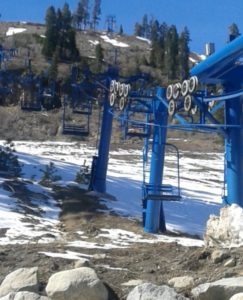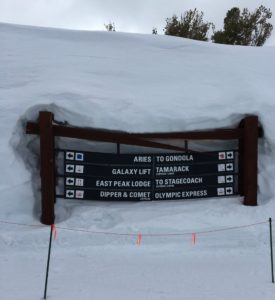The Lake Tahoe Basin is off to its third-driest start since 1980-81.
It doesn’t require a weather report to understand that Lake Tahoe ski resorts have been lacking man-made snow this season.

Following a record-breaking season of snow, the Sierra Nevada range has experienced a slow start for the 2017-18 ski season.
The official pronouncement came Dec. 28 following a survey by the Nevada Natural Resources Conservation Service, a federal agency that tracks snow in the west. The Mt. Rose Snotel site on Slide Mountain reported 36 inches of snow with 11 inches of water content, which is 84 percent of normal. On the same date in 2016, the site had 58 inches of snow and was at 119 percent of normal.
The Dec. 28 snow survey results show 30 percent of normal for the date, compared to 67 percent on Dec. 28 last year. The slow start is a reminder that drought remains a concern for the region.
“While it’s too early to know for sure if this will be a drought year, we had better start acting as though drought was going to be a normal – not abnormal – part of western water’s future,” said Peter Gleick, co-founder of the Pacific Institute, told the Reno Gazette Journal.
The Snowpack in the Truckee River Basin is 59 percent of normal and 50 to 64 percent of normal in the Walker and Carson river basins.
The dryness is glaring below 8,000 feet, where the snowpack is just 25 percent of normal to date. At this time last year, snow levels above 8,000 feet were near or above normal. Below 8,000 feet they were as much as 40 percent below normal.
Sparse snow below 8,000 feet is particularly important because it’s an indication that human-induced climate change is already altering the Sierra Nevada.
It was a memorable ski season a year ago. For the 2016-17 season, eight of the top-10 snow totals at North American ski resorts were recorded at Lake Tahoe-area ski resorts.
It was arguably the most prolific season for snow totals in Lake Tahoe history. As a result, ski resorts stayed open later for the 2016-17 season than ever before.
Sugar Bowl had the most snow among the Lake Tahoe resorts for the 2016-17 season, recording 795 inches. That put Sugar Bowl in second place among North American resorts, trailing only Mt. Baker in Washington, which had an astonishing 866 inches of snow.

Located 25 miles from Reno, Mt. Rose in Nevada recorded 768 inches, the most in resort history. Another Lake Tahoe ski resort also surpassed the 600-inch level. Sierra-at-Tahoe accumulated 625 inches. Further south, California-based Mammoth Mountain recorded 618 inches.
Squaw Valley had 728 inches of snow last season, the fifth most among North American ski resorts. The resort didn’t close for the season until July 15, offering skiing and snowboarding for a record 200 days.
“Last season was one we will not soon forget,” said Andy Wirth, president and CEO of Squaw Valley Alpine Meadows. “Mother Nature dealt out her fair share of challenges, with snow totals, wind speeds and overall volatility of weather the likes of which have never been seen in the Sierra Nevada since ski areas have been in operation. However, the monumental snowpack brought the historic opportunity to operate well into summer.”
In regards to the current lack of snow, Gleick notes that the changing climate indicates winters that were once considered average for the Sierra Nevada are increasingly rare. And conditions once considered extreme are increasingly likely.